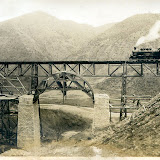Trains in photographs
Winding up the valley to the watershed,
Thro' the heather and the weather and the dawn overhead.
Past cotton-grass and moorland boulder
Shovelling white steam over her shoulder,
Snorting noisily as she passes
Silent miles of wind-bent grasses.
Thro' the heather and the weather and the dawn overhead.
Past cotton-grass and moorland boulder
Shovelling white steam over her shoulder,
Snorting noisily as she passes
Silent miles of wind-bent grasses.
W H Auden; Night Mail
As plot devices go, the train remains foolproof. Put a group of characters in an enclosed space, but one they can move through, between carriages and compartments, and have that enclosed space itself travel through landscapes and across borders. Best of all the train represents a journey; between departure and arrival a story unfolds, some mystery is solved and a dramatic encounter reconciled. The English loved the Orient Express; Agatha Christie, Graham Greene and Ian Fleming put their characters on it, the Americans preferred shorter journeys but both recognized the importance of the dining car. This was the place where secrets were revealed, over a bottle of fine wine and an excellent steak. Film makers also loved the image of the train at the station, belching steam as its mechanical parts grinded and screamed. It was a pawing bull, a beast of incredible force. So far as metaphors go, one of the best was delivered by Gabriel Garcia Marquez In 100 Years of Solitude when he described the arrival of the first train at the village as ‘a kitchen dragging a village behind it’.
In the real world trains are more functional. One settles in a seat and rarely leaves it, the food in the dining car can be as bad as it is expensive and toilets are too often the stuff of nightmares. Still, the train evokes the idea of the journey much more poignantly than the bus or the aeroplane. It offers a possibility that something might happen on board, that we will arrive at the other end changed in a way. Even the act of saying farewell at a train station has a certain melancholic romance to it. Perhaps because the farewell can be prolonged, we can see one another till the end and we know that when the train pulls away one will walk down the platform alone, the other will settle into the compartment and what; open a book or newspaper or stare out at the industrial wasteland that always seems to cocoon train stations?
The births of the locomotive and the camera were close enough for us to consider them contemporaries. In aesthetic if not actual appearance they have always mirrored one another, from the massive, clunky machines of the mid 19th century to the beautiful, streamlined creations of the 1930s and 40s. There was a sense that both represented the spirit of their times. When the Transcontinental Railroad was built to join Omaha and San Francisco in the 1860s teams of photographers were sent out to document its progress. They didn’t set out to tell the story of its construction, rather its scale; a massive venture involving thousands of workers, millions of dollars and various other record breaking statistics that pen and ink could never do justice to.
For all that, photographers have mythologized the road trip but the chronicling of train journeys has largely been the province of writers and filmmakers. Despite some brilliant cinematography in documentaries like the GPO Film Unit’s Night Mail and Jean Mitry’s Pacific 321, it’s hard to think of a single extended photo essay set on a train where travelling is the point (Paul Fusco’s Funeral Train was concerned with the journey of Robert Kennedy’s coffin and the mourners lining the track). That seems remiss. Cars do have the advantage that they can be stopped when the photographer wants to spend time capturing a scene but the train has been every bit a part of our cultural experience as the car.
With the exception of the first photograph, one from a series of images documentation the construction of a Turkish railway, the photographs in this gallery were taken by amateurs.
 |
| MYSTERY TRAIN |





No comments:
Post a Comment
Add comments here